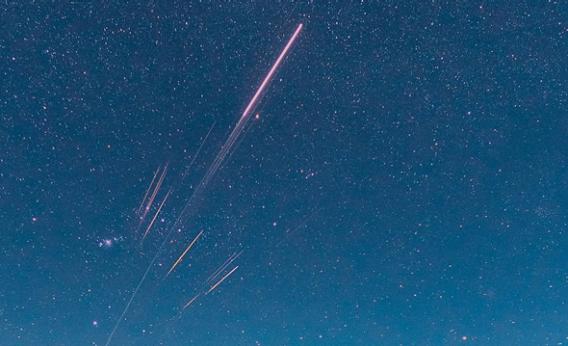Create a free profile to get unlimited access to exclusive videos, sweepstakes, and more!
SPECTACULAR Photos of a Rocket Re-Entering Over Hawaii!

Around 2 a.m. local time on Saturday, astrophotographer Steve Cullen was driving home from visiting the summit of Mauna Kea on the Big Island of Hawaii. He stopped at around 11,000 feet to take some panorama shots of the peak … but what he got was much more.
He noticed an orange light heading up into the sky out of the west. It was moving across the sky at about the speed you’d expect from a satellite, but at that time of night no satellite moving at that rate would be lit by the Sun, so it wouldn’t be visible.
Within seconds, though, it became clear what he was seeing: some sort of human-made space debris re-entering Earth’s atmosphere. How?
Because this. Check. This. OUT.
HOLY WOW! What a shot! (Click the photos for bigger, higher-resolution versions on Cullen's Facebook page.) Over the foreground of volcanic rock and more distant clouds (seen from above at that elevation), the debris came streaking toward the east, seeming bursting forth from the constellation of Orion (can you see it behind the trails?).
It turns out this was almost certainly the remains of a Chinese Long March rocket body, predicted to burn up over that area at around that time:
The rocket launched on Sept. 12, 2015, carrying a very secret satellite of some kind. Once the satellite is in orbit the rocket is no longer needed, so it’s allowed to burn up as it falls back to Earth. Doing so over the enormous Pacific Ocean minimizes the risk of debris doing any damage once it’s down.
As the rocket rams through Earth’s air, it compresses the atmospheric gas violently. A compressed gas heats up, and this is so powerful during re-entry that the heat is enough to vaporize the debris. It falls apart, each piece leaving a long trail of ionized metal and gas behind it that can glow for quite some time. They fall together, moving across the sky as a unit, though they separate over time as drag affects each piece separately.
A few minutes later, the pieces started to set in the east.
As the pieces move farther away, perspective makes it look like the trails are converging. This is the same effect that makes rays coming from sunset appear to diverge as they move away from the Sun, and sometimes converge on the other side of the sky.
Finally, once they were gone, all that was left was the bits of glowing particles, literally twisting in the wind dozens of kilometers above the Earth.
I can’t get over how amazing these photos are. I’ve seen lots of cool re-entry photos, but I think these very well might be the very best.
Mind you, Cullen happened to stop because he wanted to take a few more photos, and did so at just the right time to see this incredible event. Do I even need to say it?
Keep looking up! You never know what you might see.


























